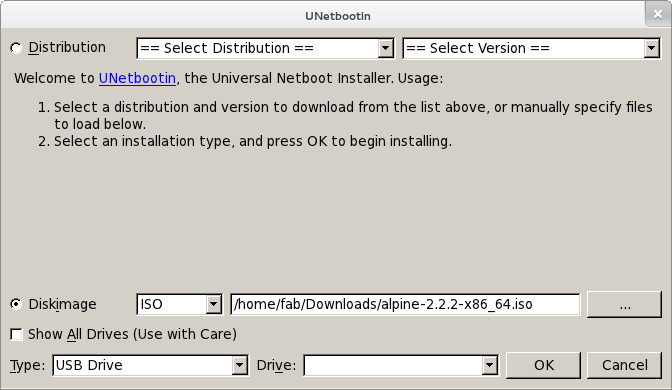Create a Bootable Device: Difference between revisions
(Remove redundant steps now included in 'Copying Alpine to Flash', added syslinux waitusb option) |
(Clearify that we are creating boot media - not really installing alpine) |
||
| Line 1: | Line 1: | ||
== | == Creating a bootable Alpine USB Stick with UNetbootin == | ||
UNetbootin is a graphical tool that allows you to create bootable Live USB drives for Ubuntu, Fedora, and other Linux distributions without burning a CD. UNetbootin is available for many distributions and Windows. | |||
=== Requirements === | === Requirements === | ||
To | To create an Alpine on a USB drive, you will need: | ||
* An Alpine Linux ISO image file ([[Downloads|Download]]) | * An Alpine Linux ISO image file ([[Downloads|Download]]) | ||
* A partitioned and formatted USB drive | * A partitioned and formatted USB drive | ||
* [http://unetbootin.sourceforge.net/ UNetbootin] | * [http://unetbootin.sourceforge.net/ UNetbootin] | ||
=== Process === | === Process === | ||
| Line 17: | Line 18: | ||
When you selected your USB device under '''Device'' and press '''OK''' to proceed. When UNetbootin is done, your USB drive is ready to use. | When you selected your USB device under '''Device'' and press '''OK''' to proceed. When UNetbootin is done, your USB drive is ready to use. | ||
== | == Creating a bootable Alpine on a USB Stick from command line == | ||
This process applies to Alpine Linux 1.9.0 or later, and results in a '''run-from-ram''' style installation. | This process applies to Alpine Linux 1.9.0 or later, and results in a '''run-from-ram''' style installation. | ||
Revision as of 16:12, 22 December 2011
Creating a bootable Alpine USB Stick with UNetbootin
UNetbootin is a graphical tool that allows you to create bootable Live USB drives for Ubuntu, Fedora, and other Linux distributions without burning a CD. UNetbootin is available for many distributions and Windows.
Requirements
To create an Alpine on a USB drive, you will need:
- An Alpine Linux ISO image file (Download)
- A partitioned and formatted USB drive
- UNetbootin
Process
After the launch of UNetbootin, click the Diskimage radio button, and then the ... button to select the Alpine ISO image.
When you selected your USB device under Device and press OK' to proceed. When UNetbootin is done, your USB drive is ready to use.
Creating a bootable Alpine on a USB Stick from command line
This process applies to Alpine Linux 1.9.0 or later, and results in a run-from-ram style installation.
Requirements
In order to follow this document, you will need:
- Alpine Linux CD-ROM (Download a .iso file containing an Alpine release.)
- A USB drive (flash, external HD, card reader, etc.)
This redirect is to an include that is obsolete and is completely unused on the wiki
(Discuss) |
Slow USB Devices
Specifying the 'waitusb=X' option at the end of the syslinux.cfg line might help with certain USB devices that take a bit longer to register. X stands for the amount of seconds kernel will wait before looking for the installation media.
append initrd=/boot/grsec.gz alpine_dev=usbdisk:vfat modules=loop,cramfs,sd-mod,usb-storage quiet waitusb=3
Alpine Linux has some special applications that helps you to use it in the way you want.
Some of the first scripts you are suggested to use is:
- setup-alpine (Configures all basic things on your Alpine Linux)
- setup-acf (was named setup-webconf before Alpine 1.9 beta 4) (Configures ACF (webconfiguration) so you can manage your box through https)
Other useful pages
- Configure Networking
- Setting up a SSH server (Using ssh is a good way to administer your box remotely)
- Package Management (apk) (How to add/remove packages on your Alpine)
- Init System (rc) (Configure a service to automatically boot at next reboot)
- Alpine local backup (lbu) (Permanently store your modifications in case your box needs reboot)

